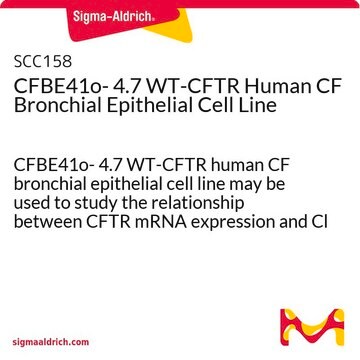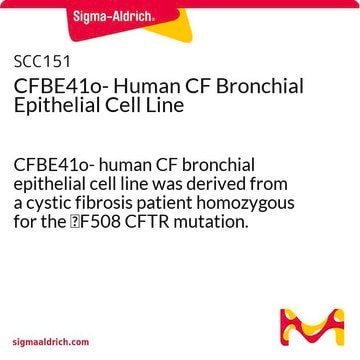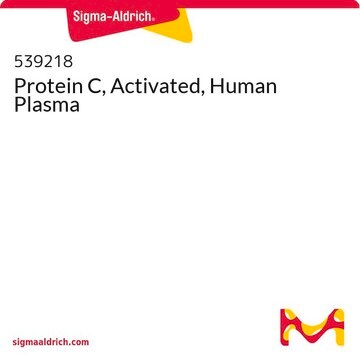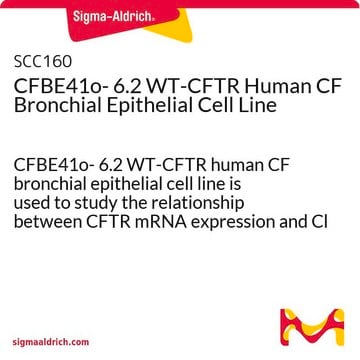SCC159
CFBE41o- 4.7 DeltaF508-CFTR Human CF Bronchial Epithelial Cell Line
Human
Synonym(s):
CFBE41o, CF41o, CFBE
About This Item
Recommended Products
product name
CFBE41o- 4.7 DeltaF508-CFTR Human CF Bronchial Epithelial Cell Line, CFBE41o- 4.7 ΔF508-CFTR human CF bronchial epithelial cell line may be used to study the relationship between CFTR mRNA expression and Cl transport function.
biological source
human
technique(s)
cell based assay: suitable
cell culture | mammalian: suitable
shipped in
ambient
General description
CFBE41o- 4.7 ΔF508-CFTR Human CF Bronchial Epithelial Cell line is a subclone derived from the electroporation of the parental CFBE41o- cell line with an Epstein-Barr virus (EBV)-based episomal pCEP4β vector containing the 4.7 kb ΔF508 CFTR open reading frame (ORF) cDNA and a Hygromycin B resistance gene .
The 4.7 kb ΔF508 CFTR cDNA contains the trinucleotide TTT deletion at the ΔF508 locus rather than the naturally occurring CTT and thus makes it possible to differentiate between endogenous ΔF508 CFTR and plasmid derived ΔF508CFTR expression. The parental CFBE41o- is a CF human bronchial epithelial cell line, derived from a CF patient homozygous for the ΔF508 CFTR mutation and immortalized with the origin-of-replication defective SV40 plasmid (pSVori-) .
Established CF bronchial epithelial cell lines that are complemented with either wild-type or ΔF508CFTR mRNA will help provide insights into the relationship between transgene-derived CFTR mRNA expression and rescue of cAMP-dependent Cl transport function.
Cell Line Description
Application
Quality
• Cells are tested by PCR and are negative for HPV-16, HPV-18, Hepatitis A, C, and HIV-1 & 2 viruses as assessed by a Human Essential CLEAR panel by Charles River Animal Diagnostic Services.
• Cells are negative for mycoplasma contamination.
• Each lot of cells is genotyped by STR analysis to verify the unique identity of the cell line.
Storage and Stability
Disclaimer
Unless otherwise stated in our catalog or other company documentation accompanying the product(s), our products are intended for research use only and are not to be used for any other purpose, which includes but is not limited to, unauthorized commercial uses, in vitro diagnostic uses, ex vivo or in vivo therapeutic uses or any type of consumption or application to humans or animals.
Storage Class Code
10 - Combustible liquids
WGK
WGK 1
Flash Point(F)
Not applicable
Flash Point(C)
Not applicable
Certificates of Analysis (COA)
Search for Certificates of Analysis (COA) by entering the products Lot/Batch Number. Lot and Batch Numbers can be found on a product’s label following the words ‘Lot’ or ‘Batch’.
Already Own This Product?
Find documentation for the products that you have recently purchased in the Document Library.
Articles
16HBE14o- human bronchial epithelial cells used to model respiratory epithelium for the research of cystic fibrosis, viral pulmonary pathology (SARS-CoV), asthma, COPD, effects of smoking and air pollution. See over 5k publications.
16HBE14o- human bronchial epithelial cells used to model respiratory epithelium for the research of cystic fibrosis, viral pulmonary pathology (SARS-CoV), asthma, COPD, effects of smoking and air pollution. See over 5k publications.
16HBE14o- human bronchial epithelial cells used to model respiratory epithelium for the research of cystic fibrosis, viral pulmonary pathology (SARS-CoV), asthma, COPD, effects of smoking and air pollution. See over 5k publications.
16HBE14o- human bronchial epithelial cells used to model respiratory epithelium for the research of cystic fibrosis, viral pulmonary pathology (SARS-CoV), asthma, COPD, effects of smoking and air pollution. See over 5k publications.
Our team of scientists has experience in all areas of research including Life Science, Material Science, Chemical Synthesis, Chromatography, Analytical and many others.
Contact Technical Service






